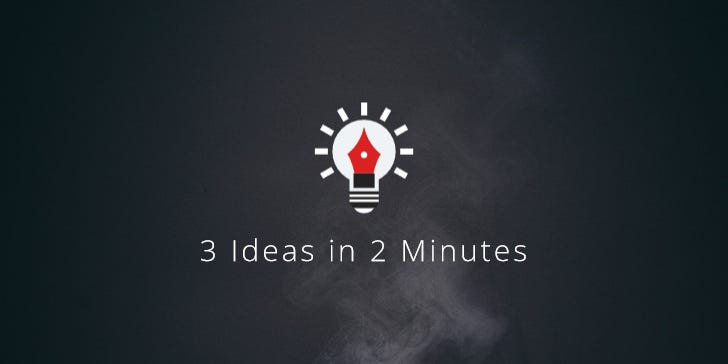#216: Miracle Razor, Doublethink & Cognitive Dissonance
3 Ideas in 2 Minutes on Cognitive Dissonance
I. Miracle Razor
True story. I once bought a desk pad from a Swedish furniture store and threw it in the back of my car. When I got home, I reached through the trunk and grabbed it from the backseat. (It was a small car). I brought it upstairs to my apartment. But when I returned to the car, my heart sank. That very desk pad had miraculously returned to the backseat!
My mind was racing, mulling every possibility, including that the universe was sending me a sign through Swedish-made office supplies. It was a miracle. How else was that possible? I’m being serious here. For about five minutes, I stood there questioning everything I knew about the world over a damn desk pad.
The truth was less exciting. It turned out that I had accidentally grabbed two pads at the store because they stuck together. When I grabbed one of them from the car, they got unstuck without me noticing. It just took me a while to put one and one together.
So whenever the seemingly miraculous happens to you, apply the Miracle Razor. It’s loosely based on contrarian Christopher Hitchens’ paraphrasing of English philosopher David Hume:
What is more likely, that the laws of the universe have been suspended — in your favour — or that you are mistaken?
II. Doublethink
War Is Peace; Freedom Is Slavery; Ignorance Is Strength.
In his dystopian novel 1984, author George Orwell masterfully dissects and illustrates ideological indoctrination by employing the thought-controlling process of Doublethink:
To know and not to know, to be conscious of complete truthfulness while telling carefully constructed lies, to hold simultaneously two opinions which cancelled out, knowing them to be contradictory and believing in both of them, to use logic against logic, to repudiate morality while laying claim to it, to believe that democracy was impossible and that the Party was the guardian of democracy, to forget whatever it was necessary to forget, then to draw it back into memory again at the moment when it was needed, and then promptly to forget it again: and above all, to apply the same process to the process itself.
That was the ultimate subtlety: consciously to induce unconsciousness, and then, once again, to become unconscious of the act of hypnosis you had just performed. Even to understand the word ‘doublethink’ involved the use of doublethink.
—George Orwell, 1984
III. Cognitive Dissonance
Cognitive Dissonance is the psychological discomfort we experience when we hold two or more conflicting beliefs. Social psychologist Leon Festinger, the father of Cognitive Dissonance Theory, knows how strong this feeling can be:
The existence of dissonance, being psychologically uncomfortable, will motivate the person to try to reduce the dissonance and achieve consonance. When dissonance is present, in addition to trying to reduce it, the person will actively avoid situations and information which would likely increase the dissonance.
―Leon Festinger, A Theory of Cognitive Dissonance
Imagine a minimalist off-the-grid survivalist YouTuber who makes daily uploads via Starlink while promoting all sorts of green powder and survival gear. How would he react to critics pointing out the hypocrisy? It’s fascinating what level of mental gymnastics we are ready to perform just to avoid facing dissonance.
Take me, for example. No matter how many people point this out and no matter how many fake screenshots you send me, I will never admit that I’ve posted the exact same text about Doublethink before. I never reuse content. So it must not be true. Period. 🐘
Have a great week,
Chris
themindcollection.com

